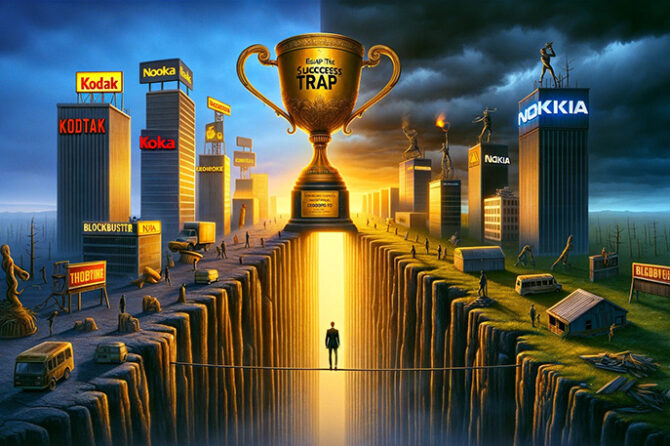
Achieving success is often seen as the pinnacle of corporate ambition, in the fast-paced world of business. Yet, as Donald Sull highlighted in his seminal 1999 paper, this very success can become a trap. This phenomenon, known as being “trapped by success,” poses a significant challenge to organizations. It leads to arrogance, an unfounded assumption of continued market dominance, and a dire failure to adapt to changing conditions. This article delves into this paradox, exploring how organizations can navigate the thin line between leveraging success and becoming ensnared by it. Through examples and case studies, such as Nestlé and Dell, we’ll uncover insights and strategies to avoid becoming “learning disabled.”
The Arrogance of Success
Success often breeds a dangerous arrogance, leading to a myopic vision that blinds organizations to the evolving demands of the market. This arrogance stems from past victories, creating a false sense of invincibility. A quotable reflection of this comes from Bill Gates, who once said, “Success is a lousy teacher. It seduces smart people into thinking they can’t lose.”
Case Study: Kodak’s Digital Dilemma
Kodak, a titan in the film industry, serves as a stark example. Despite inventing the first digital camera, Kodak’s allegiance to film photography and its underestimation of digital technology’s potential led to its downfall. The company’s success in film photography made it complacent, resulting in a failure to pivot its business model to embrace digital innovation.
Assumption of Continued Market Dominance
Organizations often assume that what brought them success in the past will continue to do so in the future. This assumption is perilous in a business landscape characterized by volatility, uncertainty, complexity, and ambiguity (VUCA).
Case Study: Nokia’s Fall from Grace
Nokia’s decline from its position as the world’s leading mobile phone manufacturer is a testament to the dangers of assuming continued market dominance. Nokia failed to recognize the shift towards smartphones and the importance of software ecosystems, allowing competitors like Apple and Samsung to redefine the market.
Failure to Adapt to Changing Conditions
The rapidly changing business environment requires organizations to be agile, constantly adapting to new trends, technologies, and consumer behaviours. Failure to do so can render a successful company obsolete almost overnight.
Case Study: Blockbuster’s Missed Opportunity
Blockbuster, once the go-to for movie rentals, failed to adapt to the changing conditions of content consumption. Its reluctance to embrace streaming services, as Netflix did, led to its eventual bankruptcy. This serves as a cautionary tale for businesses about the importance of adapting to technological advancements and changing consumer preferences.
Becoming “Learning Disabled”
The term “learning disabled” describes organizations that are unable to learn from their environment due to a reliance on past successes. This disability prevents them from recognizing the need for change, leading to stagnation and decline.
Case Study: Sears’ Slow Response to Retail Evolution
Sears, once a retail giant, became a victim of its inability to adapt to the digital age. Its slow response to online shopping trends and failure to innovate its retail experience led to a loss of market share to more agile competitors like Amazon and Walmart.
Strategies to Avoid the Trap
To avoid the trap of success, organizations must embrace several key strategies:
- Foster a Culture of Continuous Learning: Encourage curiosity and a willingness to experiment and learn from failures. As Jack Welch famously said, “An organization’s ability to learn, and translate that learning into action rapidly, is the ultimate competitive advantage.”
- Stay Customer-Centric: Always keep the changing needs and preferences of customers at the forefront of decision-making processes. This helps in staying relevant and adapting products or services accordingly.
- Embrace Agility: Develop an organizational structure that allows for quick decision-making and flexibility in response to market changes. This includes adopting practices such as agile development and lean management.
- Innovate Continuously: Innovation should not stop at the first sign of success. Organizations must continually explore new technologies, markets, and business models to stay ahead of the curve.
- Maintain Humility: Acknowledge that success is transient and that the market owes no company a continued right to exist. This humility fosters a culture of continuous improvement and vigilance.
Success, while a desirable achievement, carries with it the seeds of potential downfall. The examples of Nestlé, Dell, Kodak, Nokia, Blockbuster, and Sears serve as powerful reminders of the peril of becoming “trapped by success.” By fostering a culture of continuous learning, staying customer-centric, embracing agility, innovating continuously, and maintaining humility, organizations can navigate the challenges posed by success. As Albert Einstein wisely stated, “The measure of intelligence is the ability to change.” In the context of business, the ability to adapt and evolve is indeed the hallmark of true success.
Prof. Dr. Prahlada N. B
16 February 2024
Chitradurga.

















Prahlada Sir ,
As vividly told by you….. "success trap" refers to business organizations that focus on the exploitation of their (historically successful) current business activities and as such neglect the need to explore new territory and enhance their long-term viability.
So with one success, we shouldn't end our pursuit of learning. Infact we should try to innovate on our own success, & be in competitive mode with others in the market. Otherwise our success may become short lived, & our product may become soon outdated.
Therefore…
ReplyAfter initial success, we shoud'nt pause & sleep over it. Always we should work & innovate in tandem with the market demand & trend… in order to have continuing success in the market 🙌.
Good evening sir…. 🙏….. Thanks… A very important & useful post….. Relevent to medical practice also… Hope we all learn from it & practice right strategies to HELP the needy patients ETHICALLY….
ReplyA good explanation of the present situation of many who don’t want to change.
ReplyComplacency is the cause for many failures.
Never allow success to reach your head.